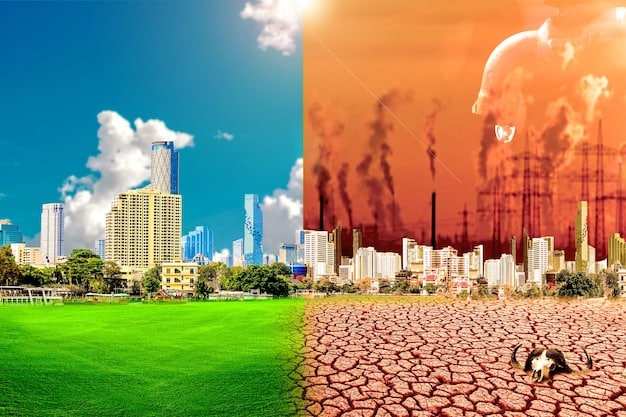Climate Change Policy: Understanding Congressional Debates & Regulations

Understanding the Latest Congressional Debates on Climate Change Policy involves dissecting proposed regulations, analyzing bipartisan disagreements, and evaluating the potential economic and environmental impacts of these legislative efforts in the United States.
Stay informed about the crucial discussions shaping our planet’s future. This article provides a comprehensive breakdown of the latest congressional debates surrounding Understanding the Latest Congressional Debates on Climate Change Policy: A Breakdown of the Proposed Regulations, offering clarity on complex proposals and their potential consequences.
The Urgency of Climate Change Policy
Climate change is no longer a distant threat; it’s a present reality impacting communities across the globe. The scientific consensus is clear: human activity is the primary driver, and urgent action is needed to mitigate its effects. This sense of urgency has fueled increased attention from policymakers, resulting in numerous proposed regulations aimed at addressing climate change.
Congressional debates on climate change policy are often fraught with partisan divisions and conflicting economic interests. Understanding the nuances of these debates is crucial for informed citizens and stakeholders alike. This article will delve into the key proposals, the arguments for and against them, and their potential ramifications.

Key Proposed Regulations and Their Objectives
Several key pieces of legislation have been proposed in Congress to tackle climate change. These proposals vary in scope and approach, reflecting different priorities and perspectives on how best to address the issue. A closer look at these regulations reveals the core objectives driving the climate change policy debate.
The Green New Deal: A Comprehensive Approach
The Green New Deal, initially introduced as a resolution, proposes a sweeping overhaul of the U.S. economy to achieve net-zero greenhouse gas emissions. Its objectives include investing in renewable energy, improving energy efficiency, upgrading infrastructure, and creating green jobs. The scale and ambition of the Green New Deal have made it a focal point of the climate change policy debate.
Carbon Pricing Mechanisms: Incentivizing Emissions Reduction
Carbon pricing mechanisms, such as carbon taxes and cap-and-trade systems, aim to reduce emissions by placing a price on carbon pollution. A carbon tax directly taxes emissions, while a cap-and-trade system sets a limit on overall emissions and allows companies to trade emission allowances. Proponents argue that these mechanisms provide economic incentives for businesses to reduce their carbon footprint.
- Carbon Tax: A tax levied on the carbon content of fuels, incentivizing a shift to cleaner energy sources.
- Cap-and-Trade: A system that limits overall emissions and allows companies to trade emission allowances.
- Revenue Recycling: Options for using revenue generated from carbon pricing, such as tax cuts or investments in green technologies.
- Economic Impacts: Potential effects on industries, consumers, and the overall economy.
These objectives represent a broad range of approaches to climate change mitigation, each with its own set of advantages and challenges. As the congressional debates unfold, it’s important to consider how these proposals align with different stakeholders’ interests and priorities.
Bipartisan Disagreements and Areas of Contention
Climate change policy often faces significant bipartisan disagreements, hindering the passage of comprehensive legislation. Differing views on the severity of the problem, the appropriate policy solutions, and the potential economic impacts contribute to these divisions. Understanding these areas of contention is crucial for navigating the complex political landscape.
Economic Impacts: Job Creation vs. Job Losses
One of the primary areas of contention revolves around the economic impacts of climate change policy. Some argue that ambitious climate action will lead to job creation in renewable energy and related industries, while others fear job losses in fossil fuel sectors and increased energy costs for consumers. These competing narratives shape the debate and influence policy decisions.
Regulatory Overreach vs. Market-Based Solutions
Another point of disagreement concerns the appropriate role of government regulation. Some advocate for strong regulatory measures to mandate emissions reductions and promote clean energy, while others prefer market-based solutions that incentivize businesses to innovate and reduce their carbon footprint. This philosophical divide often underlies policy debates and influences the design of proposed regulations.

The Role of International Agreements
The extent to which the U.S. should participate in international climate agreements is another source of contention. Some argue that international cooperation is essential for addressing climate change effectively, while others prioritize domestic interests and question the fairness of international agreements. This debate has implications for U.S. leadership on the global stage and the effectiveness of climate action.
Congressional debates on climate change policy are characterized by these and other areas of contention. Finding common ground and bridging these divides will be essential for achieving meaningful progress on climate action.
Potential Economic and Environmental Impacts
Climate change policy decisions have far-reaching economic and environmental impacts, both positive and negative. Understanding these potential consequences is essential for evaluating the effectiveness and desirability of proposed regulations. Economic impacts can include changes in energy prices, job creation, and industrial competitiveness.
Economic Growth and Innovation
Investments in renewable energy and clean technologies can drive economic growth and innovation, creating new industries and jobs. Understanding the Latest Congressional Debates on Climate Change Policy: A Breakdown of the Proposed Regulations could stimulate technological advancements that benefit the economy and the environment.
- Renewable Energy Industries: Expansion of solar, wind, and other renewable energy sectors.
- Clean Technology Innovation: Development of new technologies for emissions reduction and energy efficiency.
- Job Creation: Opportunities in green jobs, manufacturing, and research.
- Economic Competitiveness: Enhancing U.S. competitiveness in the global clean energy market.
Environmental Benefits and Climate Resilience
Effective climate change policies can lead to significant environmental benefits, such as reduced air and water pollution, improved public health, and enhanced climate resilience. These benefits can improve quality of life and protect communities from the impacts of climate change.
The climate change impacts depend heavily on the stringency and effectiveness of the policies implemented. Policymakers must carefully consider these potential impacts when crafting and evaluating climate change regulations.
The Role of Public Opinion and Advocacy Groups
Public opinion and advocacy groups play a significant role in shaping the climate change policy debate. Public awareness of climate change and support for climate action can influence policymakers and create momentum for change. Advocacy groups work to educate the public, lobby government officials, and mobilize support for specific policies.
Shaping the Narrative: Education and Awareness Campaigns
The actions of advocacy groups and public opinion are key in promoting public initiatives on government policy. Furthermore, education is a key asset for promoting awareness and shaping a new narrative.
Congressional debates on climate change policy are influenced by public opinion and the advocacy efforts of various groups. These factors can play a crucial role in shaping the outcome of policy decisions and driving progress on climate action.
Future Prospects for Climate Change Legislation
The future prospects for climate change legislation in the U.S. remain uncertain, as political dynamics and policy priorities continue to evolve. The outcome of upcoming elections, shifts in public opinion, and advancements in technology could all influence the direction of climate change policy.
Bipartisan Collaboration: Finding Common Ground
The need for an increased bipartisan effort in order to come to agreements and common ground is vital for future climate change legislation. These collaborations can have positive results if executed properly.
The Role of States and Local Governments
State and local governments are increasingly taking the lead on climate action, implementing policies and initiatives to reduce emissions and promote clean energy. Their efforts can serve as models for federal policy and help to accelerate the transition to a low-carbon economy.
Despite the challenges, there is a growing recognition of the urgency of climate action and the need for comprehensive policy solutions. As climate change impacts become more pronounced, the pressure on policymakers to act will likely intensify, creating new opportunities for progress on climate change legislation.
| Key Point 📌 | Brief Description 📝 |
|---|---|
| Green New Deal 🌿 | Aims for net-zero emissions with renewable energy investments. |
| Carbon Pricing 💰 | Includes carbon taxes and cap-and-trade systems to cut emissions. |
| Bipartisan Divides 💔 | Disagreements on economic impacts and regulatory approaches. |
| Future Prospects 🔮 | Dependent on political shifts, tech advancements, and public support. |
Frequently Asked Questions
▼
The Green New Deal is a proposed package of economic stimulus programs aimed at addressing climate change and economic inequality in the United States, aiming to transition to renewable energy.
▼
Carbon pricing mechanisms place a cost on carbon emissions to incentivize businesses and individuals to reduce their carbon footprint. This includes carbon taxes and cap-and-trade systems, promoting efficiency.
▼
The main disagreements revolve around economic impacts, the role of government regulation, and international agreements. Differing views hinder consensus on suitable policy action.
▼
Economic impacts include changes in energy prices, job creation, and industrial competitiveness. Investments can spur growth and innovation, requiring careful consideration of overall effects.
▼
You can get involved by contacting your representatives, supporting advocacy groups, and participating in public forums. Staying informed and voicing your concerns is key for progress.
Conclusion
The congressional debates on climate change policy are complex and multifaceted, reflecting the diverse perspectives and interests at stake. By **Understanding the Latest Congressional Debates on Climate Change Policy: A Breakdown of the Proposed Regulations**, and its potential consequences, we can better engage in the policy process and advocate for effective solutions to address this pressing global challenge.





